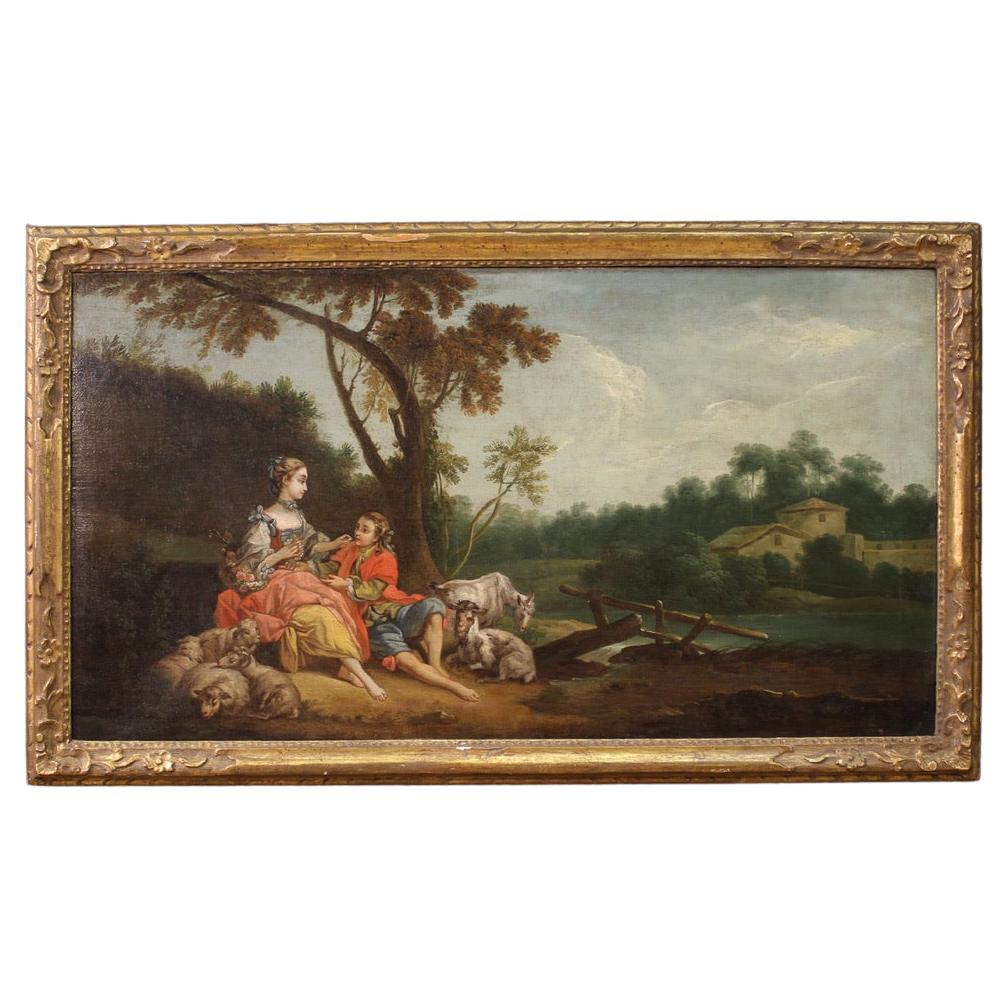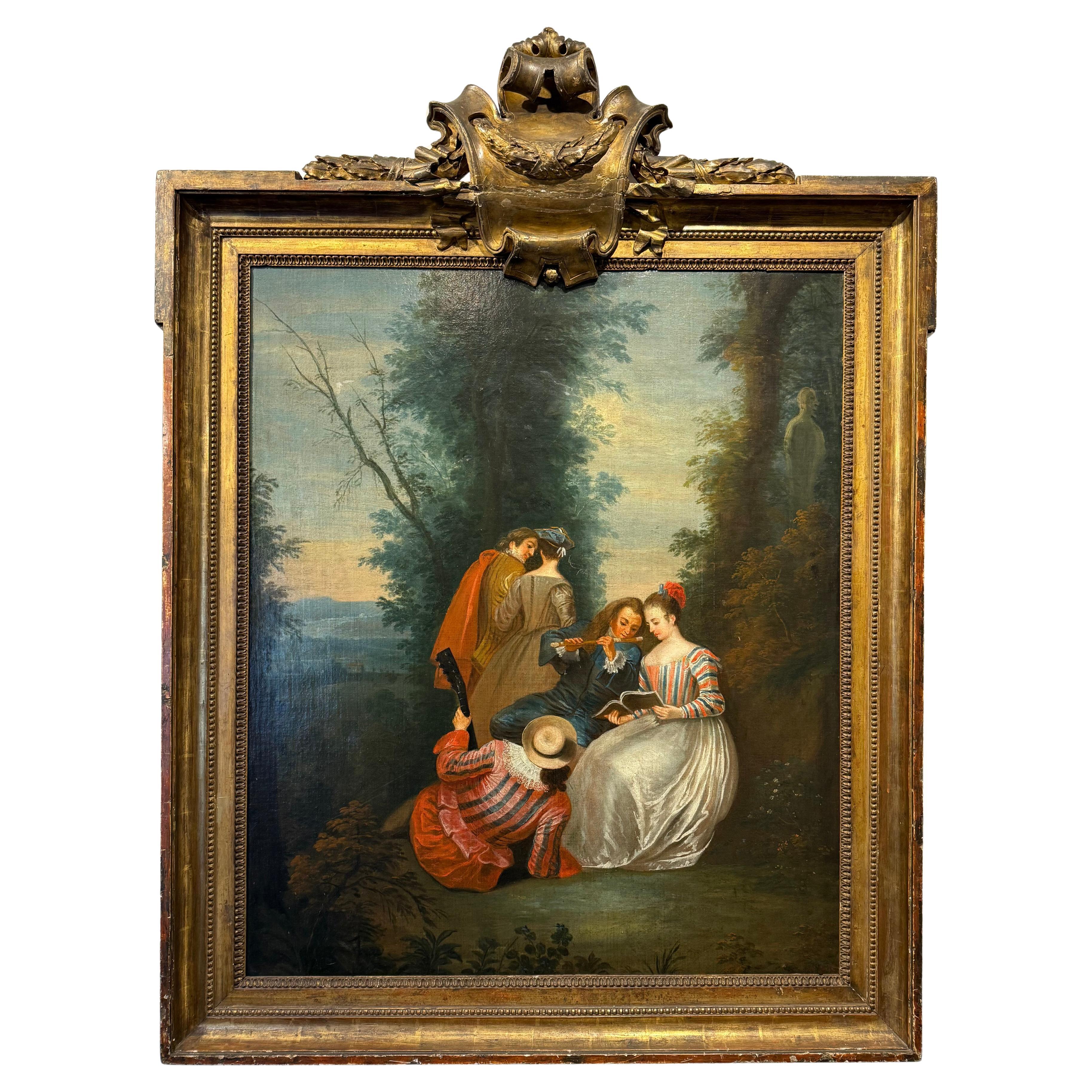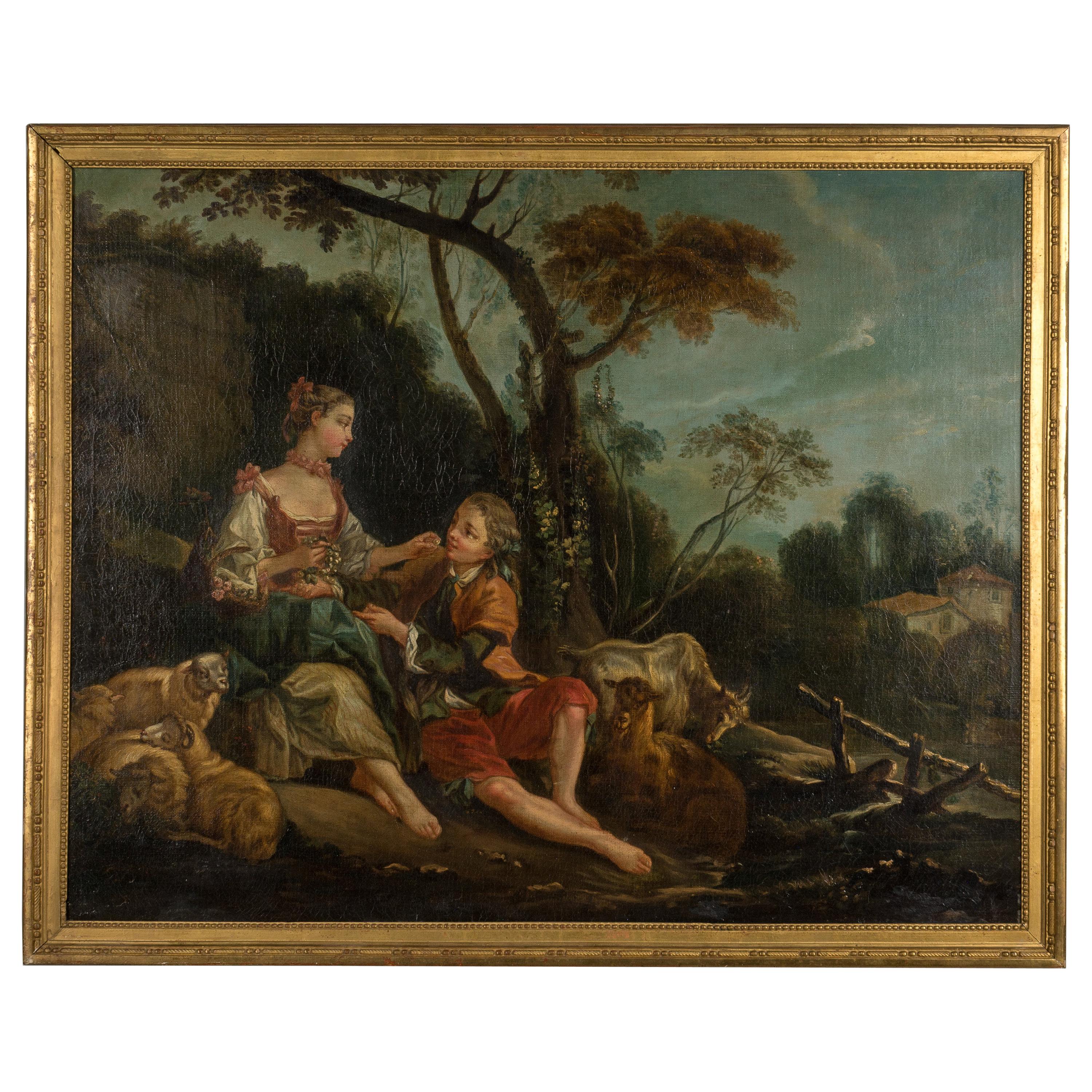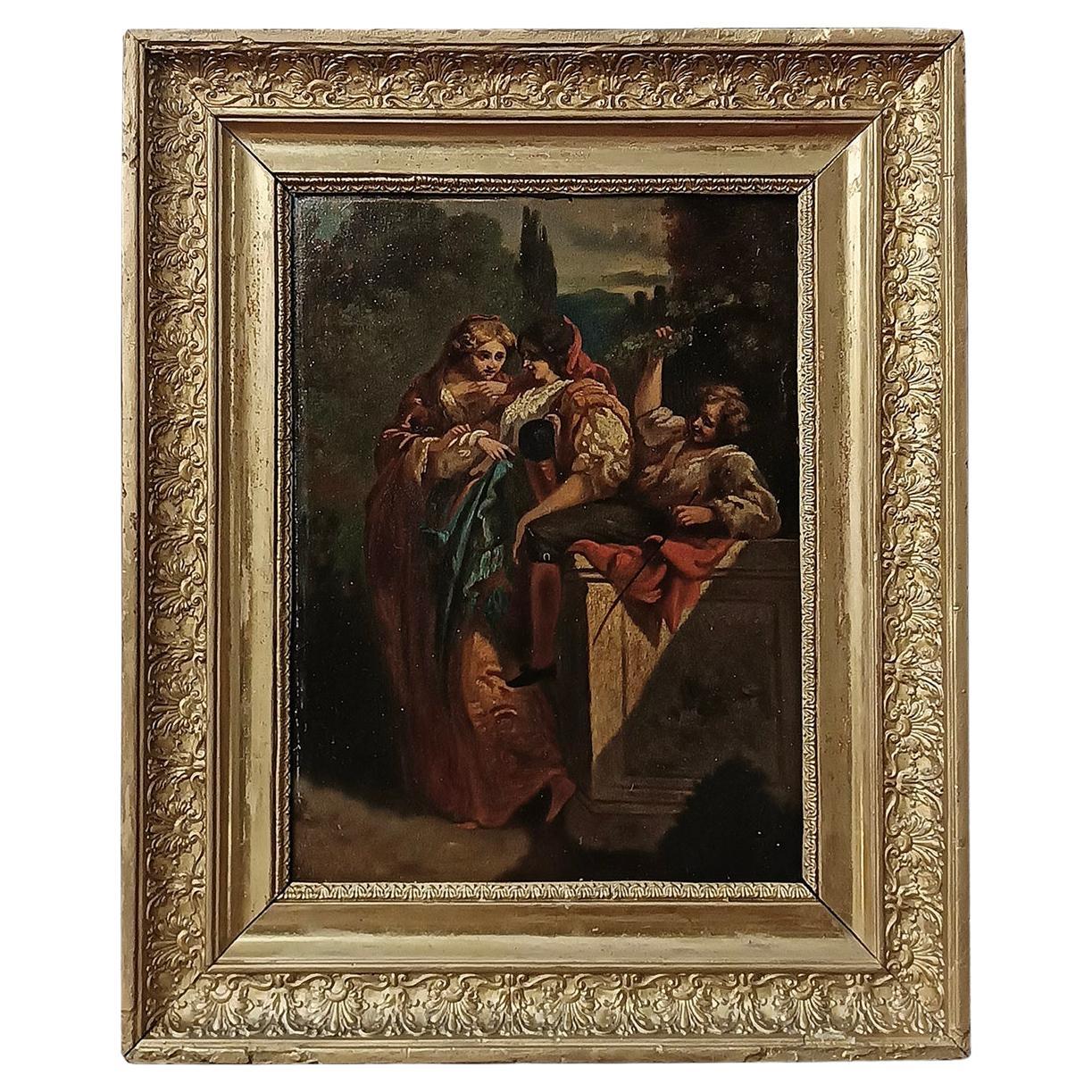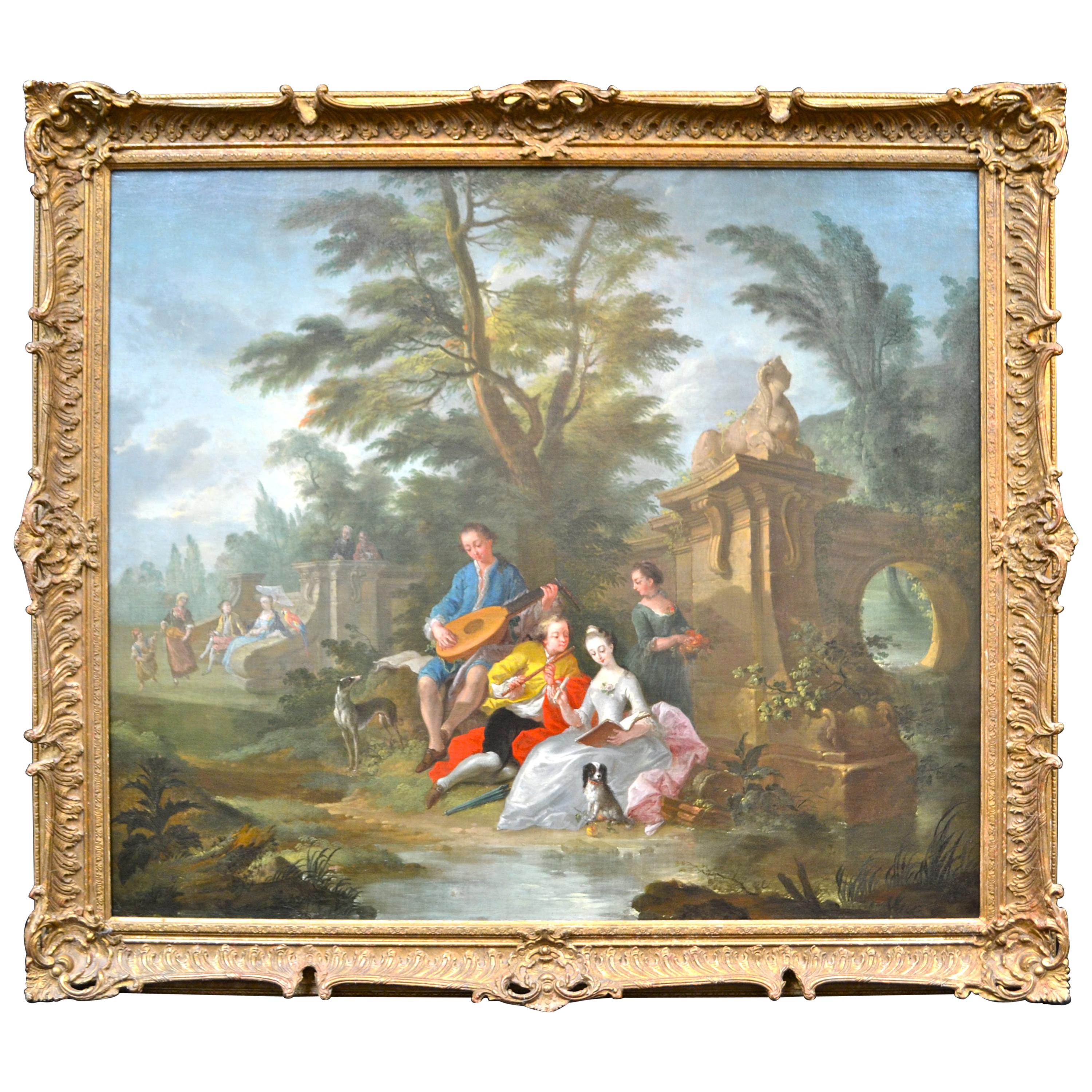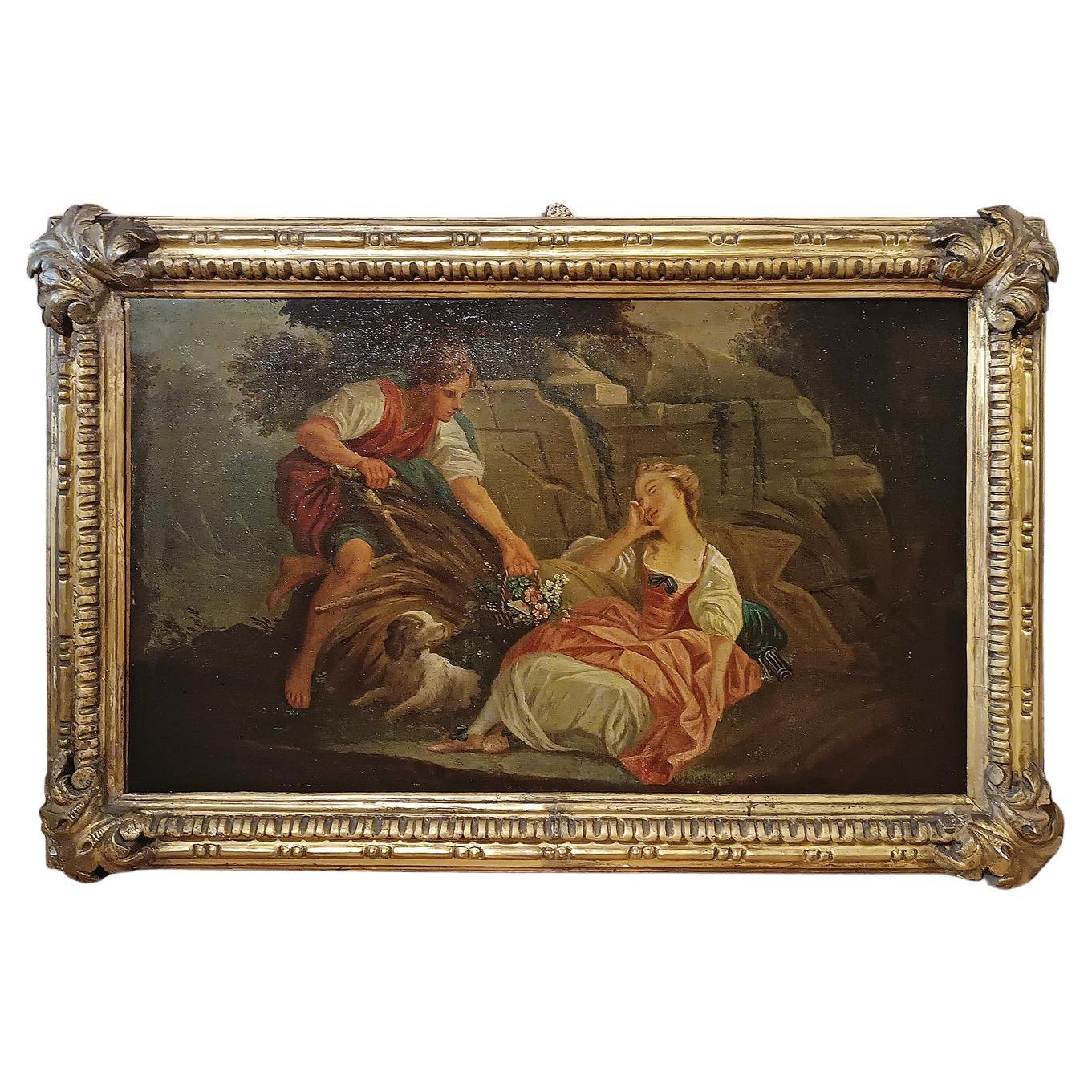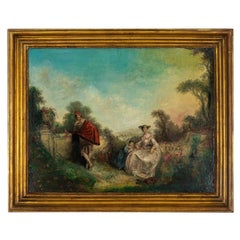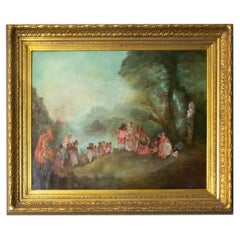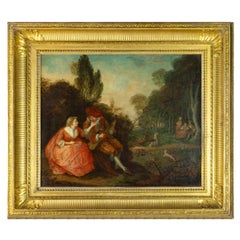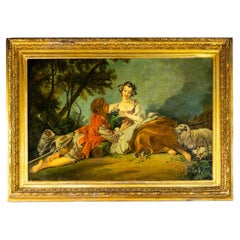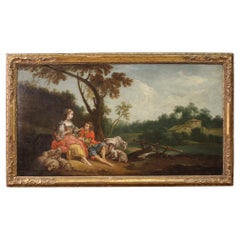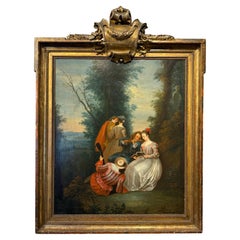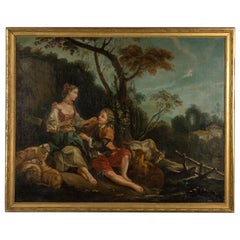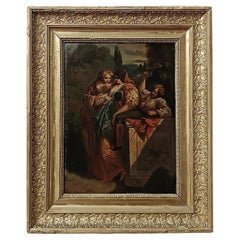Items Similar to Gallant Scene Painting by Philippe Mercier, 18th Century
Video Loading
Want more images or videos?
Request additional images or videos from the seller
1 of 12
Gallant Scene Painting by Philippe Mercier, 18th Century
$9,140.40
$11,425.5020% Off
£6,803.17
£8,503.9620% Off
€7,628.80
€9,53620% Off
CA$12,520.06
CA$15,650.0720% Off
A$13,925.04
A$17,406.3020% Off
CHF 7,271.22
CHF 9,089.0320% Off
MX$169,452.92
MX$211,816.1520% Off
NOK 92,864.61
NOK 116,080.7720% Off
SEK 87,090.62
SEK 108,863.2820% Off
DKK 58,075.39
DKK 72,594.2420% Off
Shipping
Retrieving quote...The 1stDibs Promise:
Authenticity Guarantee,
Money-Back Guarantee,
24-Hour Cancellation
About the Item
An 18th century painting of a gallant scene in a park.
Attributed with seal of painter's studio to Philippe Mercier (1689 to 1760) from the circle of the french painter Nicolas Lancret, a follower of the École of Antoine Watteau.
Oil on canvas, in a fine carved giltwood frame.
Frame:
Width: 16,53 in (42 cm)
Depth: 14,56 in (37 cm)
Canvas:
Width: 12,99 in (33 cm)
Depth: 10,62 in (27 cm)
Philippe Mercier (Berlin 1689 – London 1760) born in Berlin and studied at the Berlin Akademie with Antoine Pesne before traveling to Italy and France. By the time he arrived in London in 1716, had considerable familiarity with the work of contemporary French painters, particularly Watteau and his sophisticated style. Soon won Watteau patronage in court circles.
In 1726 painted two important group portraits that can be seen as an introduction to English art - Baron Schultz and his friends (1725, Tate Gallery, London) and Viscount Tyrconnel with his family (1725-6, private collection).
In 1729, Mercier was appointed Chief Painter to Frederick, Prince of Wales, and, a year later, keeper of his library, but they seem to have fallen away in the latter half of the 1730s, when he retired to the country, where painted several portraits for the Samwell family of Upton, Northants, and Hesilriges of Noseley, Warwicks.
In 1739 Mercier moved to York, where he built up a considerable portrait practice among
the leading families in the county. It was at this time that he made his greatest contribution to British painting, introducing and developing the 'extravagant image', a genre derived from Chardin as well as Watteau and 17th-century Dutch genre painting.
Described by George Vertue as "bit of some conversational figures as large as life: vain plaisant Fantasies and habits: mixed modes very well done – and very approved", such works were frequently recorded and clearly enjoyed considerable success.
Painted in the second half of the 1730s, the present work, An Allegory of Taste, is a fine example of this way of painting and its Rococo sensibility reveals the artist's affinities with contemporary French art.
Mercier would return to the theme of the five senses in a series of large canvases executed in the mid-1740s Mellon Collection, Yale Center for British Art.
Although later works are more complex in their treatment of subjects, they lack the charm and lightness of handling encountered in the present composition.
- Dimensions:Height: 16.54 in (42 cm)Width: 14.57 in (37 cm)Depth: 1.97 in (5 cm)
- Style:Baroque (Of the Period)
- Materials and Techniques:
- Place of Origin:
- Period:
- Date of Manufacture:18th Century
- Condition:Wear consistent with age and use.
- Seller Location:Lisbon, PT
- Reference Number:Seller: 89061stDibs: LU9157243727972
About the Seller
5.0
Vetted Professional Seller
Every seller passes strict standards for authenticity and reliability
Established in 2023
1stDibs seller since 2023
5 sales on 1stDibs
Typical response time: <1 hour
- ShippingRetrieving quote...Shipping from: Lisbon, Portugal
- Return Policy
Authenticity Guarantee
In the unlikely event there’s an issue with an item’s authenticity, contact us within 1 year for a full refund. DetailsMoney-Back Guarantee
If your item is not as described, is damaged in transit, or does not arrive, contact us within 7 days for a full refund. Details24-Hour Cancellation
You have a 24-hour grace period in which to reconsider your purchase, with no questions asked.Vetted Professional Sellers
Our world-class sellers must adhere to strict standards for service and quality, maintaining the integrity of our listings.Price-Match Guarantee
If you find that a seller listed the same item for a lower price elsewhere, we’ll match it.Trusted Global Delivery
Our best-in-class carrier network provides specialized shipping options worldwide, including custom delivery.More From This Seller
View AllRomantic Family Painting, Framed, 19th Century
Located in Lisbon, PT
This 19th-century French painting captures a tender romantic scene, set within an idyllic countryside garden under a dreamy sky.
Painted in oil on canvas with delicate brushwork and...
Category
Antique 19th Century French Baroque Revival Paintings
Materials
Canvas
$3,243 Sale Price
20% Off
Pilgrimage French Baroque Oil Painting After Jean Antoine Watteau
Located in Lisbon, PT
A very large antiqued reproduction oil painting after Jean Antoine Watteau. Apty titled "Pilgrimage" features an antiqued canvas with unique craquelure and Baroque scallioped frame. ...
Category
Antique 19th Century French Baroque Paintings
Materials
Canvas
$3,685 Sale Price
20% Off
Landscape with two central figures Baroque Painting After Antoine Watteau
Located in Lisbon, PT
A very large antiqued reproduction oil painting after Antoine Watteau. Features an antiqued canvas.
Frame: 75.5 cm (29.72 inches) x 66.5 cm (26.1...
Category
Antique 19th Century French Baroque Paintings
Materials
Canvas
$4,422 Sale Price
25% Off
Rococo Oil Painting After Boucher, Two Lovers, 19th Century
Located in Lisbon, PT
This large Rococo-style oil painting, signed “Zubriczky,” is a refined homage to the romantic compositions of François Boucher (1703–1770), one of the most celebrated artists of 18th...
Category
Antique 19th Century French Baroque Paintings
Materials
Canvas
$3,980 Sale Price
20% Off
Baroque Painting, Loving Couple, Watteau School, 18th Century
Located in Lisbon, PT
This signed 18th Century painting showcases a beautiful scene of a loving man and woman and their loyal canine companion gathered around a charming fountain, executed in the Baroque ...
Category
Antique 18th Century French Baroque Paintings
Materials
Canvas
$5,676 Sale Price
22% Off
Pair Of French Baroque Oil Painting, After Jean Antoine Watteau
Located in Lisbon, PT
A pair of two very large antiqued reproduction oil painting after Antoine Watteau:
- A very large antiqued reproduction oil painting after Antoine Watteau. Features an antiqued canv...
Category
Antique 19th Century French Baroque Paintings
Materials
Canvas
$7,305 Sale Price / set
39% Off
You May Also Like
18th Century Oil on Canvas French Antique Rococo Gallant Scene Painting, 1750
Located in Vicoforte, Piedmont
Splendid French painting from the 18th century. Oil on canvas artwork depicting a wonderful rural scene in the Rococo style with young people and grazing animals, of remarkable picto...
Category
Antique 1750s French Paintings
Materials
Canvas
A Large French Wooden Framed Oil Painting on Canvas, 18th Century
By (After) Jean-Honoré Fragonard
Located in ARMADALE, VIC
A Large French Wooden Framed Oil Painting on Canvas, 18th Century
(After) the school of Jean-Honoré Fragonard
Provenance: Private Melbourne Collection.
Dimensions:
Height: 140cm.
W...
Category
Antique 18th Century French Paintings
Materials
Canvas, Wood
18th Century French Oil Painting
Located in Winter Park, FL
A late 18th century French painting depicting a romantic couple in a pastoral setting. Oil on canvas. Unsigned. Original gilded wood frame. Small repair to canvas in the upper left c...
Category
Antique Late 18th Century French French Provincial Paintings
Materials
Giltwood, Paint
LATE 18th CENTURY SMALL PAINTING WITH A GENRE SCENE
Located in Firenze, FI
A delightful small painting, framed in a contemporary frame in carved and gilded wood, depicting a lively genre scene. In the background, an Italian garden opens up to reveal two you...
Category
Antique Late 18th Century French Paintings
Materials
Canvas, Wood, Paint
18th Century Painting Showing Figures in a Landscape Attributed to Pater
By Jean-Baptiste Pater
Located in Vancouver, British Columbia
A romantic 18th century oil painting on canvas depicting two young couples in an idyllic landscape, the figures sitting by a stream beside a garden folly, their pets with them. The two men serenade the women with their stringed instruments. The subject matter and style of painting...
Category
Antique Mid-18th Century French Louis XV Paintings
Materials
Canvas
EARLY 19th CENTURY PAINTING WITH GALANT SCENE FRENCH SCHOOL
Located in Firenze, FI
Splendid oil painting on canvas, framed in a carved and gilded pine wood frame with floral motifs. The painting depicts a gallant scene in an idyllic landscape, with ruins and trees....
Category
Antique Early 19th Century French Paintings
Materials
Canvas, Giltwood, Paint
More Ways To Browse
Italian Rococo Painting
Antique Locksmith
Antique Maltese Cross
Antique Messer
Antique Navy Rings
Antique Oak Bedside Cabinet
Antique Oak Grandfather Clocks
Antique Painted Sink
Antique Persian Tiles
Antique Red Chinese Bowl
Antique Sofa Circa 1900
Antique Specimen Drawers
Antique Spigot
Art Deco Turtle
Arts And Crafts Teapot
Asian King Beds
Atelier Di Varedo
Attache Case
